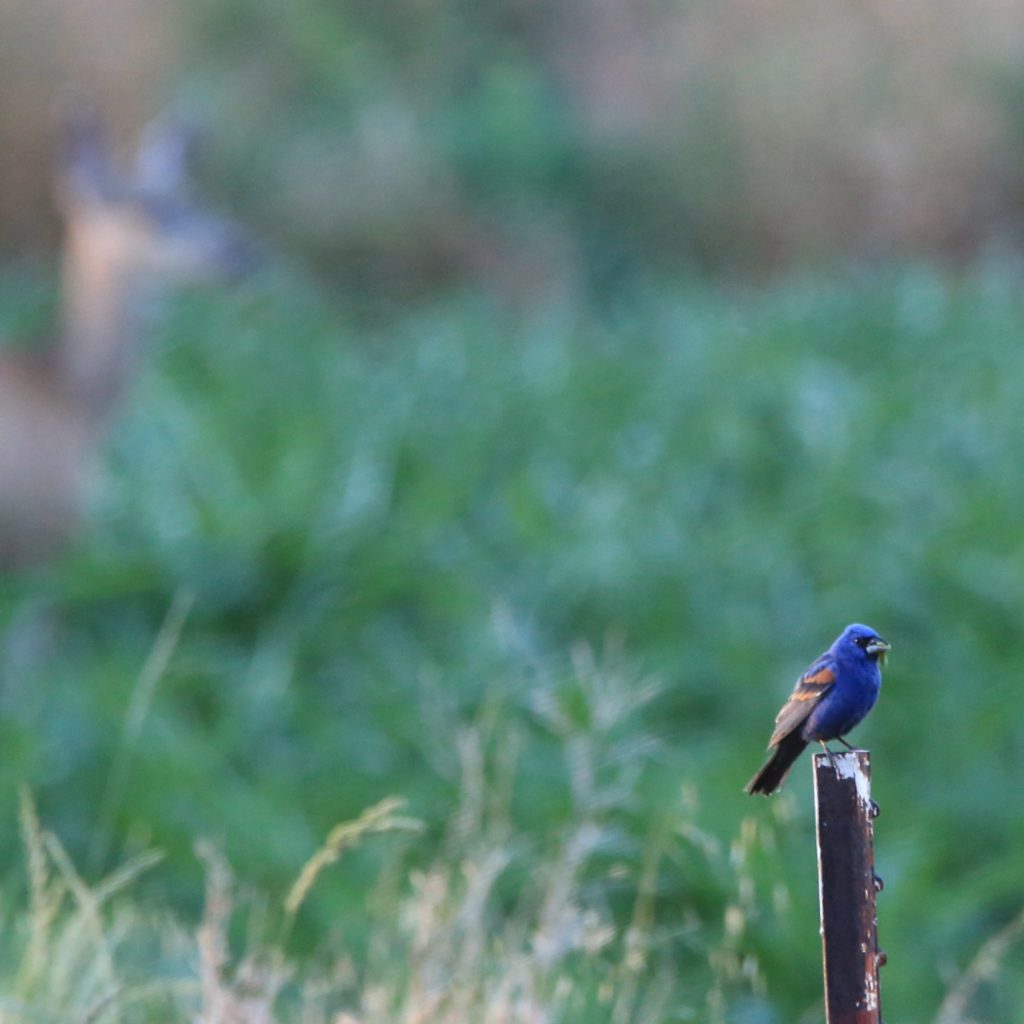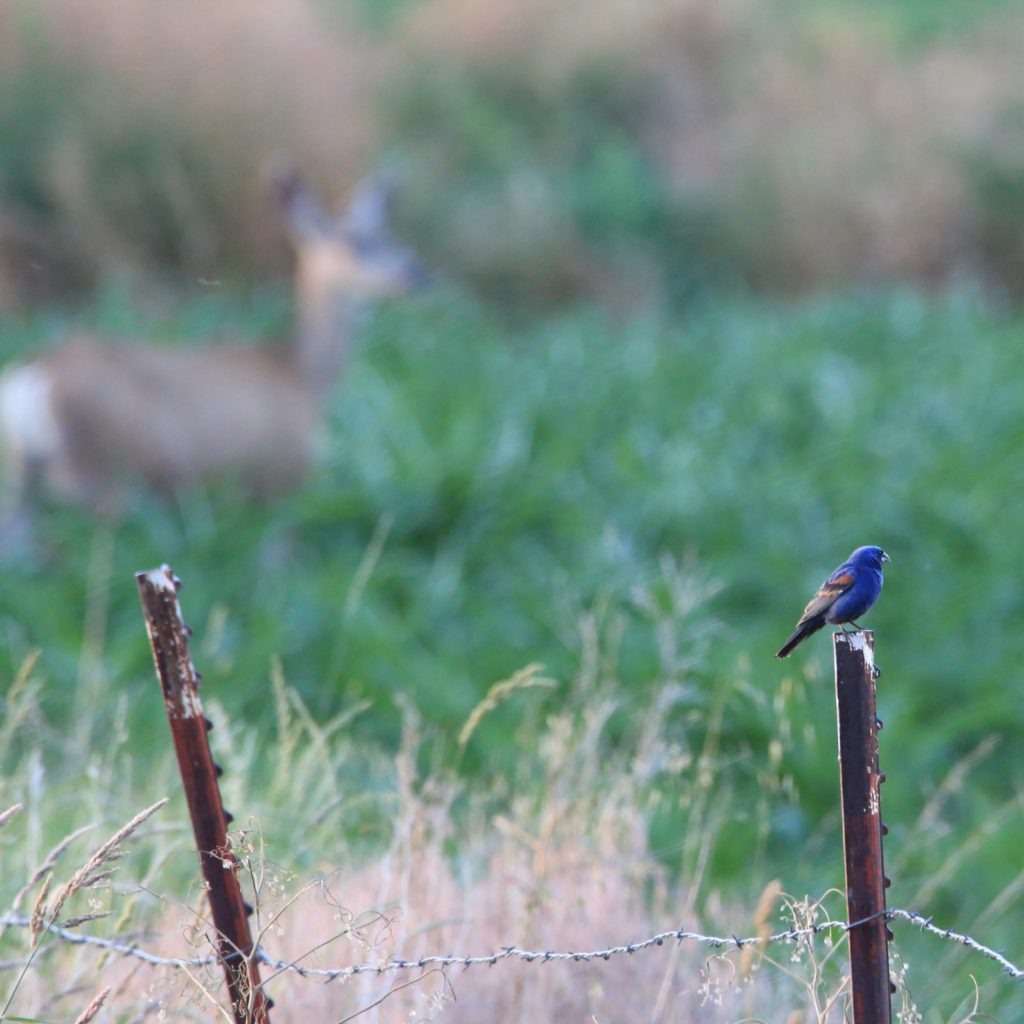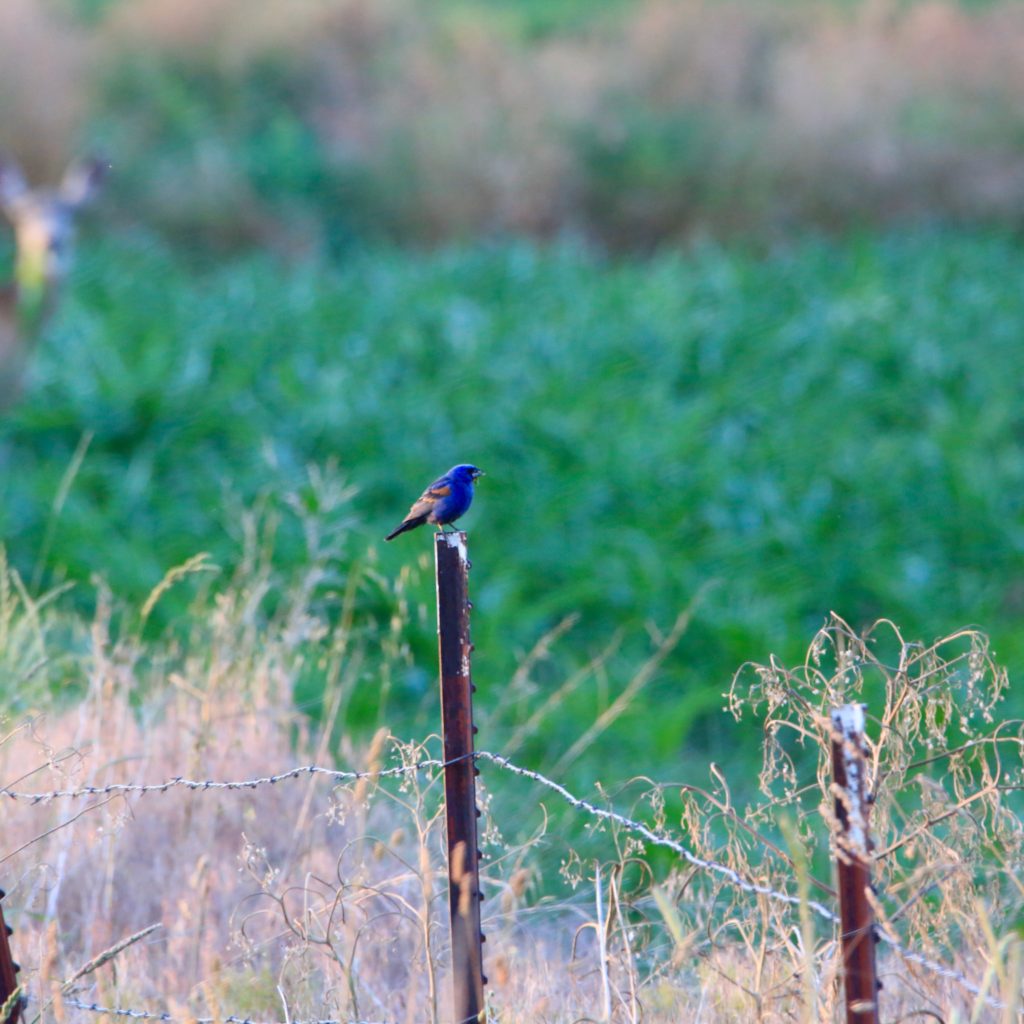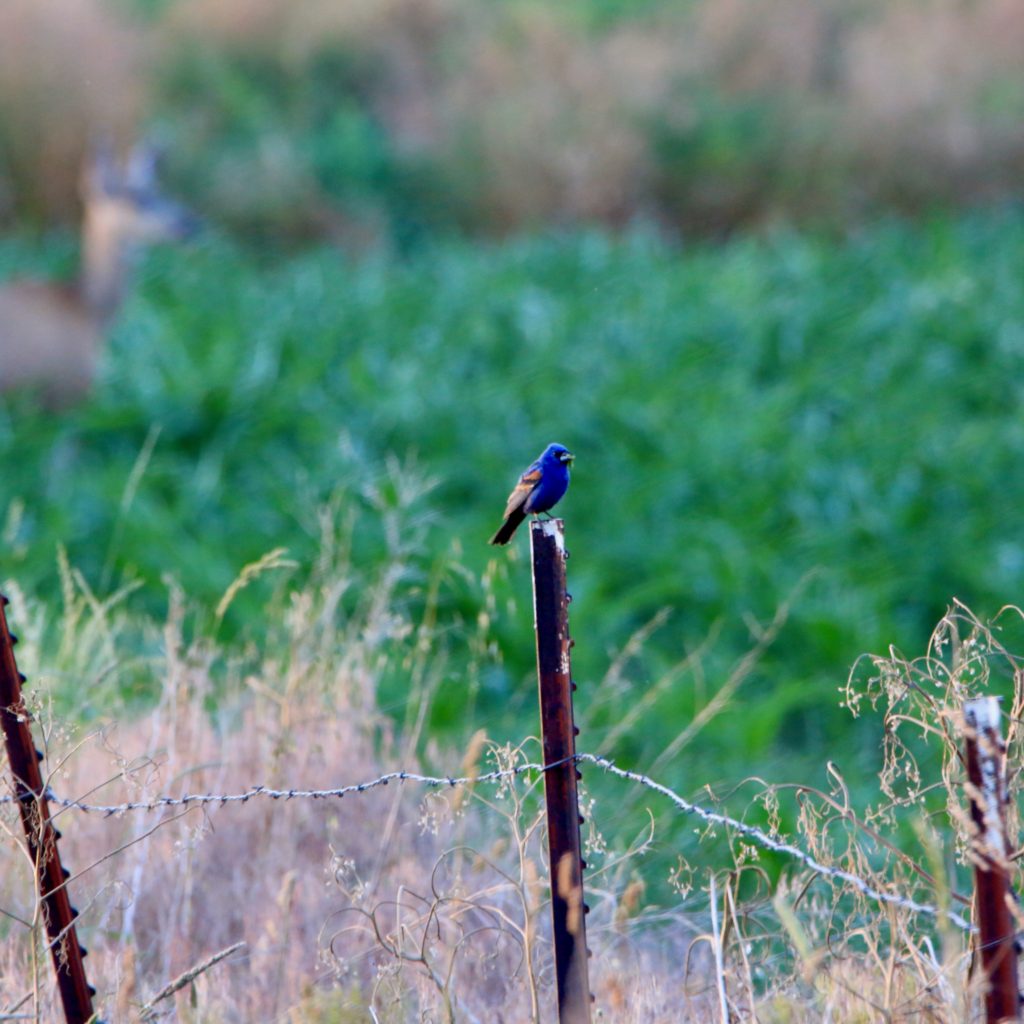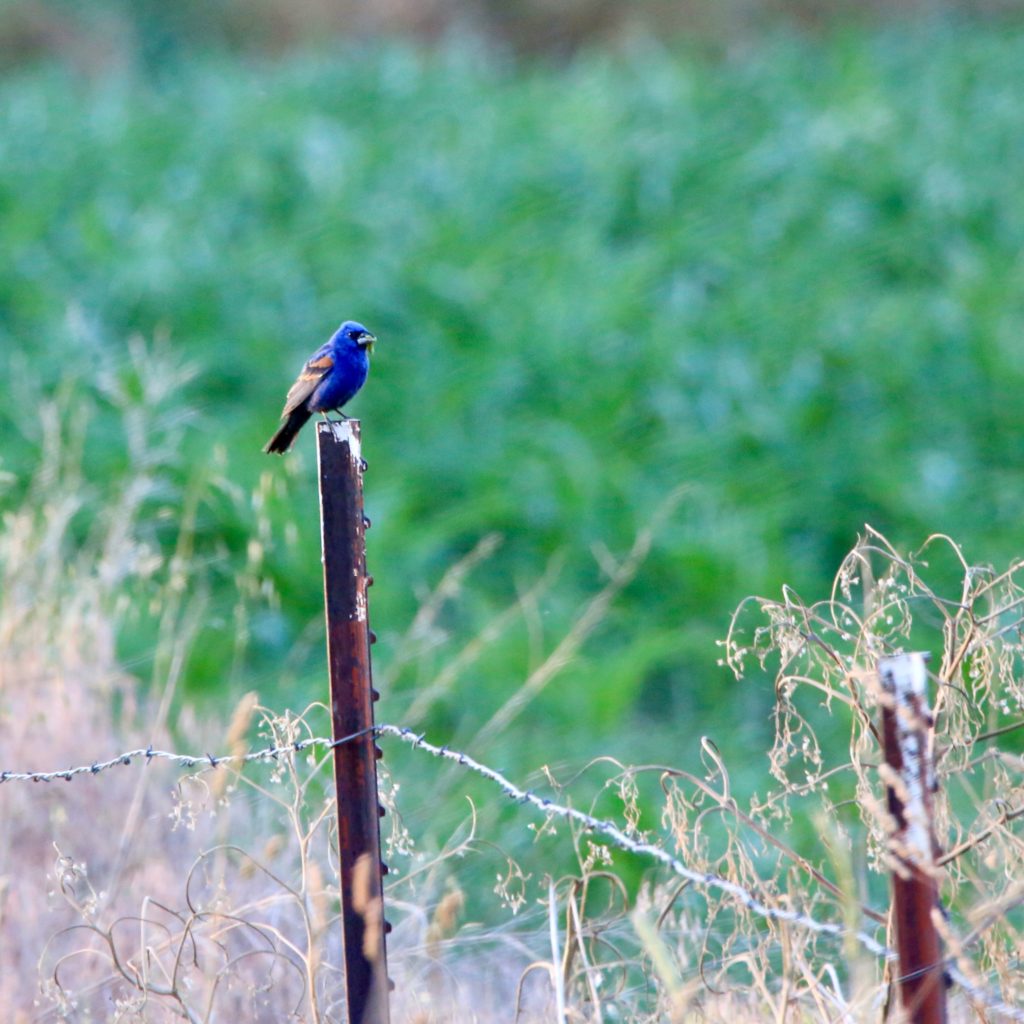
Blue Grosbeak
A Blue Grosbeak is a fun bird to see while bird watching. Below are some tips to help you identify Blue Grosbeaks. We have also put together a list of fun Blue Grosbeak t-shirts, Blue Grosbeak bird patches, bird houses, bird feeders, binoculars, stickers and other fun bird watching items.
About the Blue Grosbeak
The Blue Grosbeak is in the same family as the Northern Cardinal and a native to North America. They are medium-sized and seed-eating birds found all year round in the southern parts of North America. Most of their activities including breeding take place in the southern regions but as the decades go by, the bird is said to be moving its breeding range towards the north. Their overall population is stable and their numbers are increasing steadily.
They are migratory birds often moving south to Central America and a few towards the northern regions of North America.
Description and Identification
These stocky songbirds have large, triangular bills that seem to cover the entire face of the
birds, from the throat till the forehead. Both sexes are similar in size and range from 5.9 –
6.3 inches, with a wingspan of 11 inches. They exhibit sexual dimorphism through the
colours of their plumages. Adult males have deep, rich blue plumages with a small black
mask in front of the eyes. They also have chestnut wingbars and black-and-silver beaks.
Females are rich cinnamon-brown with the colour being the deepest on the head. Their
underparts are pale, and their tails are bluish. Immature Blue Grosbeaks resemble the
females in the colouring of the plumages.
Blue Grosbeak Color Pattern
The male is nearly entirely deep blue while its counterpart is cinnamon brown. Their large deep bill and double wing bars are what distinguishes them from other types of birds in the same family especially the Indigo Bunting which almost looks similar.
Blue Grosbeak Size
They are medium-sized birds with lengths ranging between 14-19cm and a wingspan from 26-29cm. Their weight ranges from 26-31.5g
Blue Grosbeak Behavior
The male Blue Grosbeak normally arrives at the breeding grounds first early in the season to form feeding flocks before the females arrive. The bird is monogamous and each pair can raise two broods in a single breeding season. Once they nest, the birds create a territory spanning between 2-20 acres to protect their nests from predators. When the eggs have hatched, they tend to reduce their territory.
Both the young and adult Blue Grosbeak gather in flocks to feed in grasslands, grain fields, and rice fields before migrating to other grounds for the winter season.
What Blue Grosbeak Eat
Blue Grosbeaks mainly feed on insects like grasshoppers and crickets, but can also eat
other invertebrates like snails, beetles, cicadas, treehoppers, and caterpillars. They also
incorporate a significant amount of plant matter into their diets, including the seeds of wild
and cultivated grains like wheat, oats, rice, corn, and alfalfa. They find their prey by hovering
over foliage and gleaning food from it, by catching flying insects from a perch, or even by
hunting the insects on the ground. These birds have been observed to prepare an insect
before feeding it to their nestlings for consumption, mainly by removing the head, wings, and
most of the legs.
Apart from insects, they feed on seeds and invertebrates like snails and slugs. Insects include beetles, caterpillars, treehoppers and cicadas. Seeds comprise alfalfa, corn, rice, oats, wheat, and others.
Where Blue Grosbeaks Live
Blue Grosbeaks breed in tangled vine and shrub habitats across southern North America,
ranging from New Jersey in the east, across the central United States, and into central California
in the west. They are generally found in old fields, forest edges, transmission-line corridors,
hedgerows, stream edges, deserts, mesquite savannas, salt cedar forests, and southern
pine forests. They opt for habitats that include small numbers of tree species with little
canopy coverage and low shrub densities. Their wintering habitats in Mexico and Central
America are also centered around shrubby habitats as far south as Panama. The native
communities in Mexico and Central America tend to prefer dry tropical forests and the edges
of other woodlands.
Blue Grosbeak like nesting in shrubs and thickets close to open or semi-open grounds. Breeding happens in dense entangled and low growth vine and shrub habitats. This extends from New Jersey, Central California all the way to North Dakota in the United States.
Range and Migration

Blue Grosbeaks are North American passerine birds that are mainly found breeding along with
the southern United States and northern Mexico. They are present on both coasts as well as the
dry desert areas in the southern United States during breeding. In the winters, these birds
migrate over the Gulf of Mexico and either continue southwards into Central America or
begin heading westwards across Mexico. A small population that resides in Mexico
throughout the year is also present.
Blue Grosbeak Lifecycle
Females can lay between 3-5 eggs and incubate them for 11-12 days when they hatch. The young ones leave the nest 10 days after they have hatched. Adults live to approximately 5 years.
Blue Grosbeak Nesting
The nests are built by females near open spaces or roads and are placed relatively low in
shrubs, trees, briars, or vines usually between 3 – 10 feet above the ground. On rare
occasions, nests can be made up to 25 feet high. The nests are compact and are an open
cup of twigs, weeds, rootlets, leaves, snakeskin, or strips of bark. Although the nest
construction is done by the females, the males sometimes aid in gathering materials. Odd
materials picked up from urban areas can also be used, such as paper, strings, or rags. The
inner cup of the nest is lined with fine grass, rootlets, and animal hair. Females have 1 – 2
broods each season, with the average size of each clutch ranging from 3 – 5 eggs.
Ornithology
Bird Watching Academy & Camp Subscription Boxes
At Bird Watching Academy & Camp we help kids, youth, and adults get excited and involved in bird watching. We have several monthly subscription boxes that you can subscribe to. Our monthly subscription boxes help kids, youth, and adults learn about birds, bird watching, and bird conservation.
Bird Watching Binoculars for Identifying Blue Grosbeaks
The most common types of bird watching binoculars for viewing Blue Grosbeaks are 8×21 binoculars and 10×42 binoculars. Bird Watching Academy & Camp sells really nice 8×21 binoculars and 10×42 binoculars. You can view and purchase them here.
Blue Grosbeak T-shirts
If you love the Blue Grosbeak you should purchase a Bird Watching Academy & Camp T-shirt. To help support bird conservation we donate 10 percent to bird conservation activities.
Blue Grosbeak Iron On Patches
Kids, Youth, and Adults love to collect our Bird Watching Academy & Camp iron on patches. Our bird watching patches help you keep track of the birds you have seen an identified. You can also display the patches on our Bird Watching Academy & Camp banners.
The Blue Grosbeak is a great iron on patch to start your collection with. The patches are durable and can be sewn on or ironed on to just about anything.
Blue Grosbeak Stickers
Stickers are a great way for you to display your love for bird watching and the Blue Grosbeak. We sell a monthly subscription sticker pack. The sticker packs have 12 bird stickers. These sticker packs will help your kids learn new birds every month.
Bird Feeders For Blue Grosbeak
There are many types of bird feeders. Here are our favorite bird feeders for your backyard. We use all of these bird feeders currently. Kids will have a great time watching birds eat at these bird feeders. Using this collection of bird feeders will provide a wide variety and many types of birds.
Best Bird Houses for Blue Grosbeak
There are many types of bird houses. Building a bird house is always fun but can be frustrating. These 4 bird houses have become our favorites. Getting a bird house for kids to watch birds grow is always fun. We spent a little extra money on these bird houses but they have been worth the higher price and look great.



